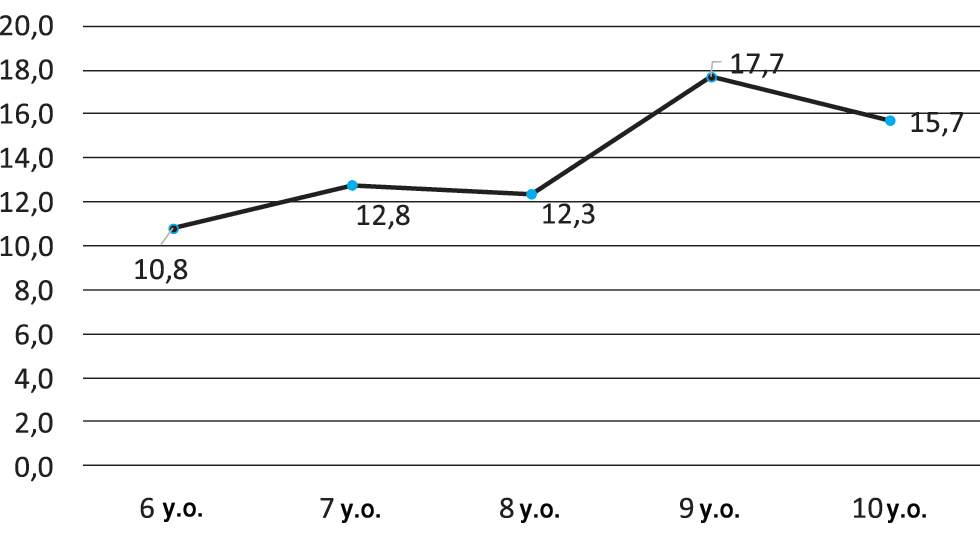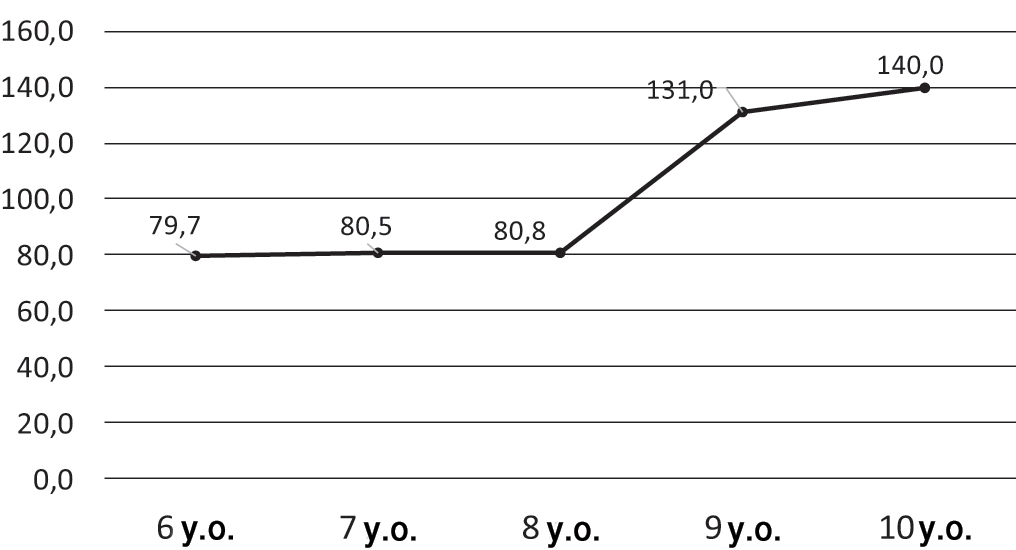Junior rhythmic gymnasts' jumping ability progress tests
Фотографии:
ˑ:
Dr.Hab., Professor O.I. Zagrevskiy
Postgraduate E.V. Beznosikova
Tomsk State University, Tomsk
Keywords: progress, motor qualities, jumping ability, tests.
Background. No initiative to improve an athletic training system for competitive success can be attained unless supported by an integrated progress control system generating dependable data on every progress component (physical, technical, tactical, mental etc.) [1-5]. Moreover, the objective fitness and progress rating data related to every aspect of the athletic training process is pivotal for success of the training process design and management viewed as a key factor of a competitive success.
Rhythmic gymnastics is the sport discipline of highest demand to a mix of coordination abilities and specific physical qualities, and the extreme and growing competitiveness of the sport makes the athletes work hard for the highest possible progress since their early days in the sport when mastering difficult routines in every discipline of the all-round events. Every apparatus in modern rhythmic gymnastics is very specific and requires, among other things, specific motor skills being developed. Rope routines, for instance, always include multiple jumping elements; clubs routines require complex coordination movement sequences done on high demi pointe; ball routines are dominated by a variety of bending and flexibility-intensive elements; and the ribbon exercises always include many turning and rotational elements, and all these skills altogether imply highest physical fitness standards being developed and maintained.
The study was designed to consider the ways to rate the athletes’ progress in jumping abilities since this ability heavily contributes to the routine performance amplitudes, artistic effects and other aspects critical for the general scores for the performance techniques in one or another routine. Jumping ability may be described as the integrated individual quality that implies high strength and speed of the muscular contractions with the optimal execution amplitudes.
Objective of the study was to obtain and analyse the junior (6-10 year-old) rhythmic gymnasts’ jumping ability progress test data.
Methods and structure of the study. The study included a few components including analysis of the reference literature, physical ability progress tests and the test data statistical processing using the Statistica v. 6.0 software toolkit. Age-group-specific jumping ability test data differences were rated using the Student’s t-criterion. Subject to the fact-finding experiment were 99 gymnasts split up into the following age groups: 6 year-olds: 22; 7 year-olds: 17; 8 year-olds 19: 9 year-olds: 21; and 10 year-olds: 20.
Study results and discussion. Given hereunder on Figures 1, 2 and in Table 1 are the statistically processed junior gymnasts’ jumping ability rating test data.

Figure 1. Standing long jump, age-specific test data, cm

Figure 2. Standing high jump: age-specific test data, cm (the Abalakov’s test)
The age-specific jumping ability rating test data showed the gymnasts’ progress with age (see Figures 1 and 2); with the 7 year-olds’ progress data were found statistically insignificant (p > 0.005) albeit the growth was still noticeable being estimated at 1.06% (see Table 1).
Table 1. Progress rates of the Standing Long Jump Test data, cm
|
Age |
Rank |
Absolute basic change |
Absolute chaining change |
Basic growth rate, % |
Chaining growth rate, % |
Absolute basic growth,% |
Absolute chaining growth, % |
Р |
|
6 |
79,7 |
|
|
|
|
|
|
|
|
7 |
80,5 |
0,85 |
0,85 |
101,06 |
101,06 |
1,06 |
1,06 |
P > 0,05 |
|
8 |
80,8 |
1,16 |
0,31 |
101,46 |
100,39 |
1,46 |
0,39 |
P > 0,05 |
|
9 |
131,0 |
51,27 |
50,11 |
164,34 |
161,99 |
64,34 |
61,99 |
P < 0,001 |
|
10 |
140,0 |
60,27 |
9,00 |
175,64 |
106,87 |
75,64 |
6,87 |
P > 0,05 |
|
Average |
|
15,07 |
|
117,58 |
|
17,58 |
|
|
The Standing High Jump Test showed very good progress as verified by the significant growth of the test rates (P < 0.05), with the average test rates of the 7 year-olds being 17.99% higher than those of the 6 year-olds: see Table 2.
Table 2. Progress rates of the Standing High Jump (Abalakov’s) Test data, cm
|
Age |
Rank |
Absolute basic change |
Absolute chaining change |
Basic growth rate, % |
Chaining growth rate, % |
Absolute basic growth,% |
Absolute chaining growth, % |
Р |
|
6 |
10,8 |
|
|
|
|
|
|
|
|
7 |
12,8 |
1,95 |
1,95 |
117,99 |
117,99 |
17,99 |
17,99 |
P < 0,05 |
|
8 |
12,3 |
1,50 |
-0,45 |
113,84 |
96,48 |
13,84 |
3,52 |
P > 0,05 |
|
9 |
17,7 |
6,90 |
5,40 |
163,75 |
143,83 |
63,75 |
43,83 |
P < 0,001 |
|
10 |
15,7 |
4,88 |
-2,01 |
145,13 |
88,63 |
45,13 |
-11,37 |
P < 0,05 |
|
Average |
|
1,22 |
|
111,73 |
|
11,73 |
|
|
The jumping tests of the 8 year-olds showed the jumping progress in this age being insignificant as verified by the Standing Long and High Jump Test rate growths of 0.39% and 3.52% (0.3 cm and 3.52 cm) respectively, the progress data difference being rated insignificant (P > 0.05).
The 9 year-olds showed progress in both of the jumping tests, with the progress rating data being found significant (P < 0.001): see Table 1 and 2. The 9 year-olds’ Standing Long Jump Test results averaged 131.0 cm that was 51.27 cm (61.99%) higher than those of the 8 year-olds. In the Standing High Jump Test, the 9 year-olds were 43.83% (6.9 cm) better than the 8 year-olds, with the absolute growth in the Standing High Jump Test making 17.7 cm. It should be noted that the rhythmic gymnasts generally showed the highest progress in the jumping ability rates in the age period of 6 to 10 years.
The 10 year-olds showed significant regress of 2.0 cm (a fall from 17.7 cm to 15.7 cm on average) in the Standing High Jump Test (Р < 0.05) versus the 9 year-olds. In the Standing Long Jump Test, however, the 10 year-olds showed some growth trend, with the average absolute result of the 10 year-olds making up 140.0 cm with the result being slightly albeit insignificantly better versus that of the 9 year-olds (P > 0.05).
Having analysed the basic rates, we found that by the age of 10 the junior gymnasts added 60.3 cm in the Standing Long Jump Test versus their 6 year-old peers, with their average result making up 140.0 cm (see Table 2), the growth being estimated at 75.64%. The growth rate in the Standing High Jump Test was lower, albeit altogether it was estimated at 45.13% (15.7 cm) on the way from 6 to 10 years of age.
Given hereunder are the speed-strength test rates also characteristic for the subjects’ jumping ability that showed the highest growth rate in the period from 8 to 10 years of age (see Table 3), the test data being supportive of the above finding on the jumping ability growth being significantly high for this age group.
Table 3. Progress rates in the 30 m Sprint Test data, seconds
|
Age |
Rank |
Absolute basic change |
Absolute chaining change |
Basic growth rate, % |
Chaining growth rate, % |
Absolute basic growth,% |
Absolute chaining growth, % |
Р |
|
6 |
6,9 |
|
|
|
|
|
|
|
|
7 |
6,8 |
-0,15 |
-0,15 |
97,84 |
97,84 |
-2,16 |
-2,16 |
P > 0,05 |
|
8 |
7,0 |
0,06 |
0,21 |
100,91 |
103,13 |
0,91 |
3,13 |
P > 0,05 |
|
9 |
6,5 |
-0,40 |
-0,46 |
94,25 |
93,40 |
-5,75 |
-6,60 |
P < 0,001 |
|
10 |
6,0 |
-0,97 |
-0,57 |
85,98 |
91,22 |
-14,02 |
-8,78 |
P < 0,001 |
|
Average |
|
|
-0,24 |
|
96,40 |
|
|
|
Conclusion
Generally, the rhythmic gymnasts’ jumping ability was found to constantly grow with age, with the growth making 60 cm and the highest test result coming to 140 cm. The yearly average growth rate, as verified by both of the jumping tests (the Standing High and Long Jump Tests), was estimated at 11.3-15.7% for this age period.
However, the jumping ability growth was found uneven over this period with the highest test rates achieved in the age period from 8 to 9 years, with the contribution of this critical year estimated at above 50% of the total progress for the study period. The Standing Long Jump Test for the same period showed an absolute growth of 51 cm in the jumping ability.
In the age period of 6 to 8 years, the growth rates were found to insignificantly vary at less than 2%. The second jumping ability growth slowdown period is the age of 9 to 10 when junior gymnasts may be tested even with some sag of the progress rates versus those of the 9 year-olds.
The study data and analyses may be beneficial for the rhythmic gymnasts’ coaches who should take full advantage of the natural period of the jumping ability being on the fastest rise (the age of 8 to 9) and perfectly know the other relevant age development specifics to apply the most efficient and relevant jumping ability development tools and methods in a timely and purposeful manner.
References
- Bleer A.N., Laptev A.I., Levushkin S.P. Upravlenie fizicheskoy podgotovkoy vysokokvalifitsirovannykh bortsov greko-rimskogo stilya na osnove dannykh kompleksnogo kontrolya [Management of physical training of highly skilled Greco-Roman wrestlers based on comprehensive monitoring data]. Vestnik sportivnoy nauki, 2013, no. 2, pp. 14-19.
- Godik M.A., Skorodumova A.P. Kompleksny kontrol v sportivnykh igrakh [Complex control in sports games]. Moscow: Sovetskiy sport publ., 2010, 336 p.
- Zagrevskiy V.O. Modelnye kharakteristiki fizicheskoy podgotovlennosti kak faktor upravleniya trenirovochnym protsessom yunykh gimnastov. Dis. kand. ped. nauk [Model characteristics of physical fitness as factor of young gymnasts' training process management. PhD diss.]. Omsk, 1999, 174 p.
- Zagrevskiy O.I., Zelenkina I.N. Faktornaya struktura fizicheskoy podgotovlennosti yunykh sportsmenok 5-10 let v khudozhestvennoy gimnastike [Factor structure of physical fitness of junior female athletes aged 5-10 years in rhythmic gymnastics]. Fizicheskaya kultura: vospitanie, obrazovanie, trenirovka, 2010, no. 5, pp. 38-41.
- Shilko V.G. Fizicheskoe vospitanie studentov na osnove lichnostno-orientirovannogo soderzhaniya fizkulturno-sportivnoy deyatelnosti [Physical education of students based on personality-centered physical culture and sports activity]. Tomsk: Tomsk State University publ., 2003, 196 p.
Corresponding author: o.zagrevsky@yandex.ru
Abstract
The article considers a few critical issues of the 6-10 year-old junior rhythmic gymnasts’ jumping ability progress verified by the age-specific progress tests. The article demonstrates that the modern test technologies including the junior rhythmic gymnasts’ jumping ability progress tests give the means to duly design and manage the education and training process. Timely solutions may be found if due priority is given to the relevant age-specific training tools when certain physical abilities of the athletes are most sensitive to modification and excelling practices. The prime objective of the study was to obtain and analyse the junior rhythmic gymnasts’ age-specific jumping ability progress test data. Statistical data generated by the study demonstrate the junior rhythmic gymnasts’ jumping ability progress being age-specific with the highest progress being normally attained in the age of 8 to 9, with this progress component accounting for above 50% of the total progress for the period as verified by the progress rating tests. The age groups of the 6-7 and 7-8 year-olds were tested with the lowest yearly progress rates estimated at 2-3% only.




